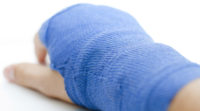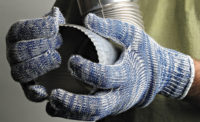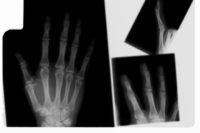Statistics on hand and arm loss

 There were 1,285,000 persons in the U.S. living with the limb loss (excluding fingers and toes) in 1996.
There were 1,285,000 persons in the U.S. living with the limb loss (excluding fingers and toes) in 1996.
The prevalence rate in 1996 was 4.9 per 1,000 persons. The incidence rate was 46.2 per 100,000 persons with dysvascular disease, 5.86 per 100,000 persons secondary to trauma, 0.35 per 100,000 secondary to malignancy of a bone or joint.
The birth prevalence of congenital limb deficiency in 1996 was 25.64 per 100,000 live births. The prevalence rate is highest among people aged 65 years and older ~ 19.4 per 1,000.
Above from: http://www.amputee-coalition.org/nllic_faq.html#2.
Numbers and percents on amputations:
- 50,000 new amputations every year in USA based on information from National Center for Health Statistics
- ratio of upper limb to lower limb amputation is 1:4
- most common is partial hand amputation with loss of 1 or more fingers, 61,000
- next common is loss of one arm, 25,000
- existence of 350,000 persons with amputations in USA, 30% have upper limb loss
- of this, wrist and hand amputations are estimated to make up 10% of upper limb population
- transradial amputations make up 60% of total wrist and hand amputations
- which means 70% of all persons with upper limb amputations have amputations distal to the elbow(3)
- In US 41,000 persons are registered who had an amputation of hand or complete arm
- 60% of arm amputations are between ages 21 and 64 years and 10% are under 21 years of age
Causes leading to amputation:
Reasons for amputation include cardiovascular disease, traumatic accidents, infection, tumors, nerve injury (trophic ulceration), and congenital anomalies
Most frequent causes of upper limb amputation are trauma and cancer, followed by vascular complications of disease right arm more frequently involved in work related injuries
Congenital upper limb deficiency has an incidence of approximately 4.1 per 10000 live births
Table 1 - Causes of Upper Extremity Amputation (in percent)
Congenital . . . . . . . . . . . . . . . . . . . . . . . . . . . . . . .8.9%
Tumor. . . . . . . . . . . . . . . . . . . . . . . . . . . . . . . . . . 8.2%
Disease . . . . . . . . . . . . . . . . . . . . . . . . . . . . . . . . . 5.8%
Trauma . . . . . . . . . . . . . . . . . . . . . . . . . . . . . . . . 77%
All above from http://biomed.brown.edu/Courses/BI108/BI108_2003_Groups/Hand_Prosthetics/stats.html
Who references the following
Hand injuries and occupational accidents. Statistics and prevention
From Centre de Controle medical des accidents du travail, Paris.
- Hand injuries count for a 1/3 of all injuries at work, 1/3 of chronic injuries, 1/4 of lost working time, 1/5 of permanent disability.
- This varies from activity to activity and with the material element involved.
- An average of 22 working days are lost, but this varies according to lesion.
(USA 1983-1986, from the Digest of Data on Person with Disabilitities, U.S. Department of Education, prepared January 1992)
More than 3 million people in the USA have a disability in their hands and/or forearms, including paralyzations, orthopedic impairments, either congenital or injury related.
"Faces of Adoption," "National Adoption Center," website)
About one in every 2000 new born babies will have some form of a limb deficiency; it may be absent parts of fingers or toes, complete absence of all four limbs or something in between. Another larger group of children lose limbs in accidents, especially to lawn mowers, trains, all terrain vehicles, and motorcycles; or to disease, including cancer.
According to the LIMBS FOR LIFE FOUNDATION:
"Every week 2,996 people lose a limb."
A survey regarding extremity amputations & mental health issues conducted by Ron VanDerNoord, MD of the Frazier Rehab Center in cooperation with the Amputee Coalition of America provides the following insight into amputee rehabilitation:
- "75% of amputees said they needed more education than they were given from their medical professionals."
- "57% of amputees said they received NO educational materials."
- "Of the 43% who did receive materials, only 15-20% of the available materials were considered helpful."
SOURCE: www.aboutonehandtyping.com
Looking for a reprint of this article?
From high-res PDFs to custom plaques, order your copy today!





